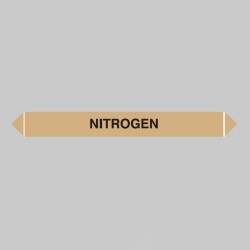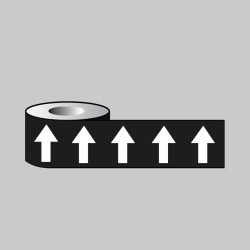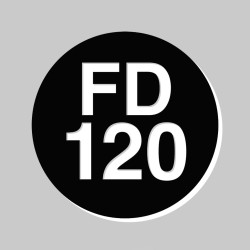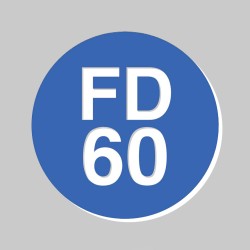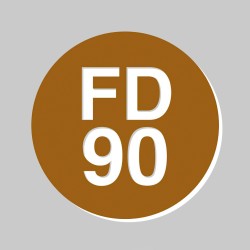Safety Signs Search
Products meeting the search criteria
Nitrogen - Flow Marker (Pack of 5) Safety Signs
The Health and Safety (Safety Signs and Signals) Regulations 1996 require employers to mark visible pipes in the workplace which contain or transport dangerous substances. BS171 1984 Identification of Pipelines and Services, specifies the colours to be used for the identification of pipes containing..
Gas - Flow Marker (Pack of 5) Safety Signs
The Health and Safety (Safety Signs and Signals) Regulations 1996 require employers to mark visible pipes in the workplace which contain or transport dangerous substances. BS171 1984 Identification of Pipelines and Services, specifies the colours to be used for the identification of pipes containing..
Natural Gas - Flow Marker (Pack of 5) Safety Signs
The Health and Safety (Safety Signs and Signals) Regulations 1996 require employers to mark visible pipes in the workplace which contain or transport dangerous substances. BS171 1984 Identification of Pipelines and Services, specifies the colours to be used for the identification of pipes containing..
Propane - Flow Marker (Pack of 5) Safety Signs
The Health and Safety (Safety Signs and Signals) Regulations 1996 require employers to mark visible pipes in the workplace which contain or transport dangerous substances. BS171 1984 Identification of Pipelines and Services, specifies the colours to be used for the identification of pipes containing..
Methane - Flow Marker (Pack of 5) Safety Signs
The Health and Safety (Safety Signs and Signals) Regulations 1996 require employers to mark visible pipes in the workplace which contain or transport dangerous substances. BS171 1984 Identification of Pipelines and Services, specifies the colours to be used for the identification of pipes containing..
Co2 - Flow Marker (Pack of 5) Safety Signs
The Health and Safety (Safety Signs and Signals) Regulations 1996 require employers to mark visible pipes in the workplace which contain or transport dangerous substances. BS171 1984 Identification of Pipelines and Services, specifies the colours to be used for the identification of pipes containing..
Cold Water - Flow Marker (Pack of 5) Safety Signs
The Health and Safety (Safety Signs and Signals) Regulations 1996 require employers to mark visible pipes in the workplace which contain or transport dangerous substances. BS171 1984 Identification of Pipelines and Services, specifies the colours to be used for the identification of pipes containing..
Waste Water - Flow Marker (Pack of 5) Safety Signs
The Health and Safety (Safety Signs and Signals) Regulations 1996 require employers to mark visible pipes in the workplace which contain or transport dangerous substances. BS171 1984 Identification of Pipelines and Services, specifies the colours to be used for the identification of pipes containing..
Cooling Water - Flow Marker (Pack of 5) Safety Signs
The Health and Safety (Safety Signs and Signals) Regulations 1996 require employers to mark visible pipes in the workplace which contain or transport dangerous substances. BS171 1984 Identification of Pipelines and Services, specifies the colours to be used for the identification of pipes containing..
Condensate - Flow Marker (Pack of 5) Safety Signs
The Health and Safety (Safety Signs and Signals) Regulations 1996 require employers to mark visible pipes in the workplace which contain or transport dangerous substances. BS171 1984 Identification of Pipelines and Services, specifies the colours to be used for the identification of pipes containing..
Drinking Water - Flow Marker (Pack of 5) Safety Signs
The Health and Safety (Safety Signs and Signals) Regulations 1996 require employers to mark visible pipes in the workplace which contain or transport dangerous substances. BS171 1984 Identification of Pipelines and Services, specifies the colours to be used for the identification of pipes containing..
Hot Water - Flow Marker (Pack of 5) Safety Signs
The Health and Safety (Safety Signs and Signals) Regulations 1996 require employers to mark visible pipes in the workplace which contain or transport dangerous substances. BS171 1984 Identification of Pipelines and Services, specifies the colours to be used for the identification of pipes containing..
Heating - Flow Marker (Pack of 5) Safety Signs
The Health and Safety (Safety Signs and Signals) Regulations 1996 require employers to mark visible pipes in the workplace which contain or transport dangerous substances. BS171 1984 Identification of Pipelines and Services, specifies the colours to be used for the identification of pipes containing..
Fresh Water - Flow Marker (Pack of 5) Safety Signs
The Health and Safety (Safety Signs and Signals) Regulations 1996 require employers to mark visible pipes in the workplace which contain or transport dangerous substances. BS171 1984 Identification of Pipelines and Services, specifies the colours to be used for the identification of pipes containing..
Non Drinking Water - Flow Marker (Pack of 5) Safety Signs
The Health and Safety (Safety Signs and Signals) Regulations 1996 require employers to mark visible pipes in the workplace which contain or transport dangerous substances. BS171 1984 Identification of Pipelines and Services, specifies the colours to be used for the identification of pipes containing..
Steam - Flow Marker (Pack of 5) Safety Signs
The Health and Safety (Safety Signs and Signals) Regulations 1996 require employers to mark visible pipes in the workplace which contain or transport dangerous substances. BS171 1984 Identification of Pipelines and Services, specifies the colours to be used for the identification of pipes containing..
Electricity - Flow Marker (Pack of 5) Safety Signs
The Health and Safety (Safety Signs and Signals) Regulations 1996 require employers to mark visible pipes in the workplace which contain or transport dangerous substances. BS171 1984 Identification of Pipelines and Services, specifies the colours to be used for the identification of pipes containing..
Nitric Acid - Flow Marker (Pack of 5) Safety Signs
The Health and Safety (Safety Signs and Signals) Regulations 1996 require employers to mark visible pipes in the workplace which contain or transport dangerous substances. BS171 1984 Identification of Pipelines and Services, specifies the colours to be used for the identification of pipes containing..
Sulphuric Acid - Flow Marker (Pack of 5) Safety Signs
The Health and Safety (Safety Signs and Signals) Regulations 1996 require employers to mark visible pipes in the workplace which contain or transport dangerous substances. BS171 1984 Identification of Pipelines and Services, specifies the colours to be used for the identification of pipes containing..
Caustic Soda - Flow Marker (Pack of 5) Safety Signs
The Health and Safety (Safety Signs and Signals) Regulations 1996 require employers to mark visible pipes in the workplace which contain or transport dangerous substances. BS171 1984 Identification of Pipelines and Services, specifies the colours to be used for the identification of pipes containing..
Hydrochloric Acid - Flow Marker (Pack of 5) Safety Signs
The Health and Safety (Safety Signs and Signals) Regulations 1996 require employers to mark visible pipes in the workplace which contain or transport dangerous substances. BS171 1984 Identification of Pipelines and Services, specifies the colours to be used for the identification of pipes containing..
Sodium Hydroxide - Flow Marker (Pack of 5) Safety Signs
The Health and Safety (Safety Signs and Signals) Regulations 1996 require employers to mark visible pipes in the workplace which contain or transport dangerous substances. BS171 1984 Identification of Pipelines and Services, specifies the colours to be used for the identification of pipes containing..
Hydrogen Peroxide - Flow Marker (Pack of 5) Safety Signs
The Health and Safety (Safety Signs and Signals) Regulations 1996 require employers to mark visible pipes in the workplace which contain or transport dangerous substances. BS171 1984 Identification of Pipelines and Services, specifies the colours to be used for the identification of pipes containing..
Oil - Flow Marker (Pack of 5) Safety Signs
The Health and Safety (Safety Signs and Signals) Regulations 1996 require employers to mark visible pipes in the workplace which contain or transport dangerous substances. BS171 1984 Identification of Pipelines and Services, specifies the colours to be used for the identification of pipes containing..
Heating Oil - Flow Marker (Pack of 5) Safety Signs
The Health and Safety (Safety Signs and Signals) Regulations 1996 require employers to mark visible pipes in the workplace which contain or transport dangerous substances. BS171 1984 Identification of Pipelines and Services, specifies the colours to be used for the identification of pipes containing..
Fuel Oil - Flow Marker (Pack of 5) Safety Signs
The Health and Safety (Safety Signs and Signals) Regulations 1996 require employers to mark visible pipes in the workplace which contain or transport dangerous substances. BS171 1984 Identification of Pipelines and Services, specifies the colours to be used for the identification of pipes containing..
Diesel Oil - Flow Marker (Pack of 5) Safety Signs
The Health and Safety (Safety Signs and Signals) Regulations 1996 require employers to mark visible pipes in the workplace which contain or transport dangerous substances. BS171 1984 Identification of Pipelines and Services, specifies the colours to be used for the identification of pipes containing..
Air - Flow Marker (Pack of 5) Safety Signs
The Health and Safety (Safety Signs and Signals) Regulations 1996 require employers to mark visible pipes in the workplace which contain or transport dangerous substances. BS171 1984 Identification of Pipelines and Services, specifies the colours to be used for the identification of pipes containing..
Compressed Air - Flow Marker (Pack of 5) Safety Signs
The Health and Safety (Safety Signs and Signals) Regulations 1996 require employers to mark visible pipes in the workplace which contain or transport dangerous substances. BS171 1984 Identification of Pipelines and Services, specifies the colours to be used for the identification of pipes containing..
Green Pipe Band - Water Safety Signs
The Health and Safety (Safety Signs and Signals) Regulations 1996 require employers to mark visible pipes in the workplace which contain or transport dangerous substances. BS171 1984 Identification of Pipelines and Services, specifies the colours to be used for the identification of pipes containing..
Silver / Grey Pipe Band - Steam Safety Signs
The Health and Safety (Safety Signs and Signals) Regulations 1996 require employers to mark visible pipes in the workplace which contain or transport dangerous substances. BS171 1984 Identification of Pipelines and Services, specifies the colours to be used for the identification of pipes containing..
Brown Pipe Band - Oils Safety Signs
The Health and Safety (Safety Signs and Signals) Regulations 1996 require employers to mark visible pipes in the workplace which contain or transport dangerous substances. BS171 1984 Identification of Pipelines and Services, specifies the colours to be used for the identification of pipes containing..
Ochre Pipe Band - Gas Safety Signs
The Health and Safety (Safety Signs and Signals) Regulations 1996 require employers to mark visible pipes in the workplace which contain or transport dangerous substances. BS171 1984 Identification of Pipelines and Services, specifies the colours to be used for the identification of pipes containing..
Violet Pipe Band - Acids / Alkalis Safety Signs
The Health and Safety (Safety Signs and Signals) Regulations 1996 require employers to mark visible pipes in the workplace which contain or transport dangerous substances. BS171 1984 Identification of Pipelines and Services, specifies the colours to be used for the identification of pipes containing..
Light Blue Pipe Band - Air Safety Signs
The Health and Safety (Safety Signs and Signals) Regulations 1996 require employers to mark visible pipes in the workplace which contain or transport dangerous substances. BS171 1984 Identification of Pipelines and Services, specifies the colours to be used for the identification of pipes containing..
Black Pipe Band - Other Liquids Safety Signs
The Health and Safety (Safety Signs and Signals) Regulations 1996 require employers to mark visible pipes in the workplace which contain or transport dangerous substances. BS171 1984 Identification of Pipelines and Services, specifies the colours to be used for the identification of pipes containing..
Orange Pipe Band - Electricity / Ventilation Safety Signs
The Health and Safety (Safety Signs and Signals) Regulations 1996 require employers to mark visible pipes in the workplace which contain or transport dangerous substances. BS171 1984 Identification of Pipelines and Services, specifies the colours to be used for the identification of pipes containing..
Red Pipe Band - Fire Fighting Safety Signs
The Health and Safety (Safety Signs and Signals) Regulations 1996 require employers to mark visible pipes in the workplace which contain or transport dangerous substances. BS171 1984 Identification of Pipelines and Services, specifies the colours to be used for the identification of pipes containing..
Yellow Pipe Band - Warnings Safety Signs
The Health and Safety (Safety Signs and Signals) Regulations 1996 require employers to mark visible pipes in the workplace which contain or transport dangerous substances. BS171 1984 Identification of Pipelines and Services, specifies the colours to be used for the identification of pipes containing..
Auxiliary Blue Pipe Band - Fresh Water Safety Signs
The Health and Safety (Safety Signs and Signals) Regulations 1996 require employers to mark visible pipes in the workplace which contain or transport dangerous substances. BS171 1984 Identification of Pipelines and Services, specifies the colours to be used for the identification of pipes containing..
Black Arrows On White - Pipeline ID Tape Safety Signs
Self-adhesive directional flow marking labels. Simply cut and apply around the pipe using the arrows to indicate the direction of flow inside the pipe.BS 171and BS 48 compliant. Material Options Explained Below is a more detailed description of the materials this particular safety sign is availa..
Black Arrows On Green - Pipeline ID Tape Safety Signs
Self-adhesive directional flow marking labels. Simply cut and apply around the pipe using the arrows to indicate the direction of flow inside the pipe.BS 171and BS 48 compliant. Material Options Explained Below is a more detailed description of the materials this particular safety sign is availa..
Black Arrows On Clear - Pipeline ID Tape Safety Signs
Self-adhesive directional flow marking labels. Simply cut and apply around the pipe using the arrows to indicate the direction of flow inside the pipe.BS 171and BS 48 compliant. Material Options Explained Below is a more detailed description of the materials this particular safety sign is availa..
White Arrows On Brown - Pipeline ID Tape Safety Signs
Self-adhesive directional flow marking labels. Simply cut and apply around the pipe using the arrows to indicate the direction of flow inside the pipe.BS 171and BS 48 compliant. Material Options Explained Below is a more detailed description of the materials this particular safety sign is availa..
White Arrows On Black - Pipeline ID Tape Safety Signs
Self-adhesive directional flow marking labels. Simply cut and apply around the pipe using the arrows to indicate the direction of flow inside the pipe.BS 171and BS 48 compliant. Material Options Explained Below is a more detailed description of the materials this particular safety sign is availa..
Black Arrows On Light Blue - Pipeline ID Tape Safety Signs
Self-adhesive directional flow marking labels. Simply cut and apply around the pipe using the arrows to indicate the direction of flow inside the pipe.BS 171and BS 48 compliant. Material Options Explained Below is a more detailed description of the materials this particular safety sign is availa..
FD120 - Fire Door ID Tag (Pack of 50) Safety Signs
All fire doors are rated. Some are FD120 (providing 120 min protection) others FD30, FD60, FD90 (30, 60, 90 min protection). Colour coded and compulsory in some organisations, these signs can be fixed to the door allowing easy identification of the doors fire rating without needing to view the door..
FD30 - Fire Door ID Tags (Pack of 50) Safety Signs
All fire doors are rated. Some are FD30 (providing 30 min protection) others FD60, FD90, FD120 (60, 90, 120 min protection). Colour coded and compulsory in some organisations, these signs can be fixed to the door allowing easy identification of the doors fire rating without needing to view the door ..
FD60 - Fire Door ID Tag (Pack of 50) Safety Signs
All fire doors are rated. Some are FD60 (providing 60 min protection) others FD30, FD90, FD120 (30, 90, 120 min protection). Colour coded and compulsory in some organisations, these signs can be fixed to the door allowing easy identification of the doors fire rating without needing to view the door ..
FD90 - Fire Door ID Tag (Pack of 50) Safety Signs
All fire doors are rated. Some are FD90 (providing 90 min protection) others FD30, FD60, FD120 (30, 60, 120 min protection). Colour coded and compulsory in some organisations, these signs can be fixed to the door allowing easy identification of the doors fire rating without needing to view the door..

